Poor posture and sitting for a long time can increase our chances of developing tech neck: neck pain caused by prolonged use of technology. Here is a list of stretch deskercises, tools, and resources to relax those muscles.
We are glued to our laptops all day, whether we are working on a kitchen countertop, coffee shop, or at our work desks, our necks are more often than not strained or hurt after sitting for prolonged periods of time. Tech Neck is a type of neck pain that occurs when the balance between the head and neck is disrupted due to being hunched over a digital device. When we are bending our necks to look down at our computer or phones, it creates a heavy strain on the neck. Consider trying to balance a 10-pound ball on a chopstick with elastic bands, if the bowling ball is consistently tilted on the edge of the chopsticks, the elastic bands would become stretched beyond their original condition. The same goes for our neck and head: hyperextension of our necks will eventually cause strain and pain.
If neck pain is not treated or relieved, it can lead to many other symptoms like headaches, carpal tunnel syndrome, and insomnia. Here are some stretching tools and resources to relieve tech neck.
Stretching
On average, we spend 15 hours a day sitting; research shows that sitting for a prolonged period of time is detrimental to our health and increases the risk of developing cancer. Deskercise is a simple and quick stretching workout to help minimise the chances of developing early-onset diseases. To prevent these issues from becoming more severe, here are 4 deskercise stretches that can be done while in the office to relieve neck pain.
1. Neck Rotations
Turning your head side-to-side will help reduce tension in the side and back of the neck to give your neck more mobility. It is important to rotate slowly to prevent further stress on the cervical spine.
Motion: Keep your back straight and legs on the ground. Turn your head to the right, looking over your shoulder, stop when you feel a pull on the left side of your neck, hold for 5 – 10 seconds, then turn to the left for 5-10 seconds. Repeat 3 times.
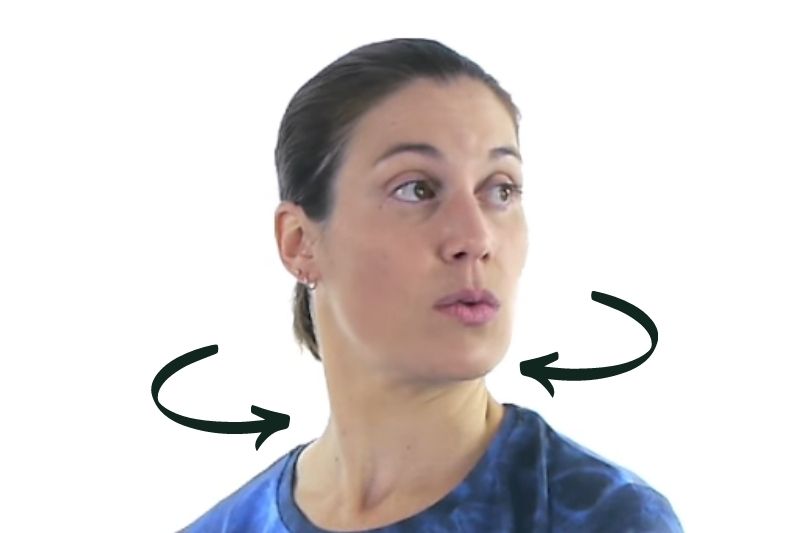
2. Flexion Stretch
Flexion refers to the bending movement between two body parts, the head and neck. It is beneficial since it increases intervertebral space between each disc which can greatly improve your posture and mobility.
Motion: Sit in a chair with your back straight, put your hands together and interlock your fingers, then put both hands behind your head for support. Slowly push your head downward, stretching the back of your neck. Then switch the hands to support your forehead, hold for 20 seconds, and repeat 3 – 4 times.
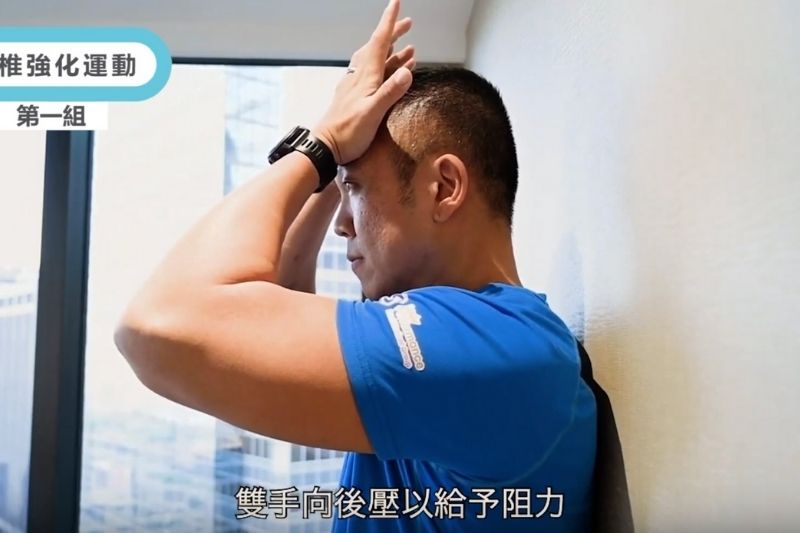
3. Shoulder Blade Pull
Shoulder blade pulls are best to avoid having rounded shoulders, and they help provide stability when lifting heavy objects, pushing, and pulling. Shoulder blade pulls also can help with correcting posture, and strengthening shoulder blades to avoid hunching over your desk.
Motion: While sitting, bend and raise your arms at a 90-degree angle and push your elbows back as if you are pulling something. Squeezing your shoulder blades together, hold for 3 seconds, release, and repeat 5 times.

4. Shoulder Shrug
The trapezius muscles are back muscles located on either side of the neck. When looking down at your phone or computer, your trapezius muscles are stretched. If not treated, symptoms like stiff neck, muscular weakness, and arthritis will appear. Shoulder shrugs will boost your muscles, strengthen your neck, and also decrease tension on the trapezius muscles.
Motion: In a seated position, inhale and hold your breath while lifting your shoulders straight up. Hold for 2 seconds, then breath out and slowly drop your shoulders. Repeat this motion 8 to 10 times for optimal results.
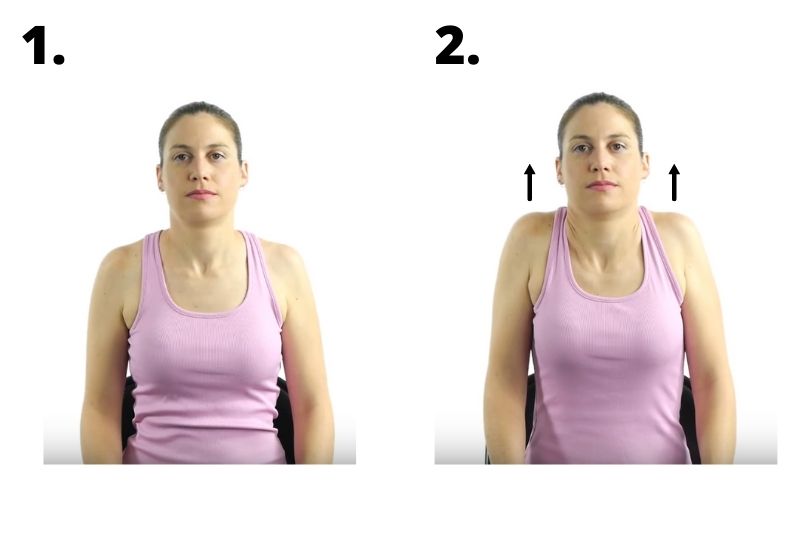
Wellness Youtube Channels
When at home, it’s sometimes hard to follow written instructions, so here is a list of youtube channels with stretch exercise videos to reduce neck pain.
1. Chloe Ting
During the pandemic, with everyone having stay-at-home quarantine, the “Chloe Ting Challenge” was trending all over various social media platforms like TikTok, Instagram, and Youtube, where users would post their successful ab results after following her weekly workout programmes. The Australian YouTuber has a subscriber count of 19.1 million and has many instructional stretching videos, especially for cooling down after a workout.
2. Emi Wong
Emi Wong is a 29-year-old fitness YouTuber from Hong Kong, whose videos offer short intense workouts. Besides workout videos, her channel also includes many stretching exercises for beginners, building core strength, and stretches after sitting for extended periods of time.

3. AskDoctorJo- Physical Therapist
Combining cute dogs and stretching exercises, Doctor Jo is a physiotherapist with over 1M subscribers. Her stretching and exercise videos are designed mainly to target common injuries like knee pain, carpal tunnel syndrome, and arthritis. Her videos are educational and provide demonstrations, therefore it is best to consult a medical professional before doing any of these workouts to prevent any conditions from worsening.
4. Dr. Matty Wong- Chiropractor
With 27K subscribers after just a year since starting her Youtube channel, Dr. Matty Wong is the first actively certified Cox® practitioner in Hong Kong. Although her videos are in Cantonese with Chinese subtitles, viewers are still able to follow along with the exercises provided to help strengthen and stretch muscles to relieve pain. Dr. Wong’s videos are informative and address common injuries like sciatica, tennis elbow, and neck pain.

Apps for Stretching
Here are 3 apps with stretching programmes, which you can easily follow at home or work. For a more extensive list, check out our Home Workout Guide.
1. Sworkit
First launched in 2014, Sworkit provides personalised programmes specifically designed to fit your needs. Simply input your personal information, goals, and desired difficulty level, and the app will suggest different plans for you to choose from. From yoga to HIIT (high intensity interval training), this app is perfect for those who want to do a quick workout during lunch hour.
Subscription Fee: US$7/ month, 30 day free trial
Availability: iOS, Android
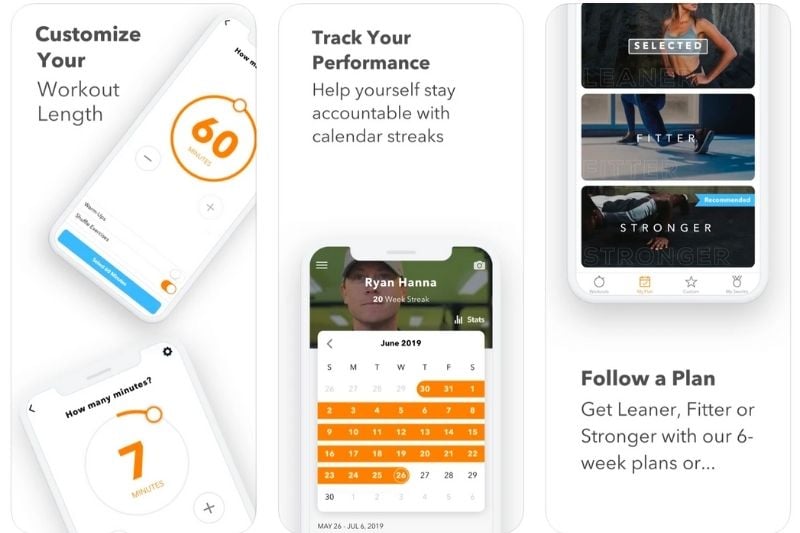
2. Sweat: Kayla Itsines Fitness
Australian fitness personal trainer, Kayla Itsines created this app in 2015 after gaining popularity from her Instagram videos, Youtube videos, and ebooks. The app includes multi-week workout programmes, meal plans, and guidance to ensure users are living a healthy lifestyle. Using a combination of yoga and core strengthening, these stretches will definitely build up muscles, aid in pain relief, and improve flexibility.
Subscription Fee: US $19.99/ month
Availability: iOS, Andriod
3. Stretchit
With world-class flexibility instruction, and multiple challenges to choose from, Stretchit uses a progress-oriented approach to encourage their users to reach their goals. Using a combination of yoga, gymnastics, pilates, and dance stretching, users of any age and background are able to follow the videos to improve posture and relieve muscle pain.
Subscription Fee: US $19.99/month
Availability: iOS, Android
4. Daily Yoga
Based in Xi’an, Daily Yoga is an app which offers more than 200+ classes for yoga, pilates, meditation from instructors located in different parts of the world. They have different stretching sets available in the app for you to follow and stretch along with a trainer. To better fit your goals, there are also various fitness tips where users can gain insights backed with scientific evidence.
Subscription Fee: US $9.99/ month
Available on: iOS, Android
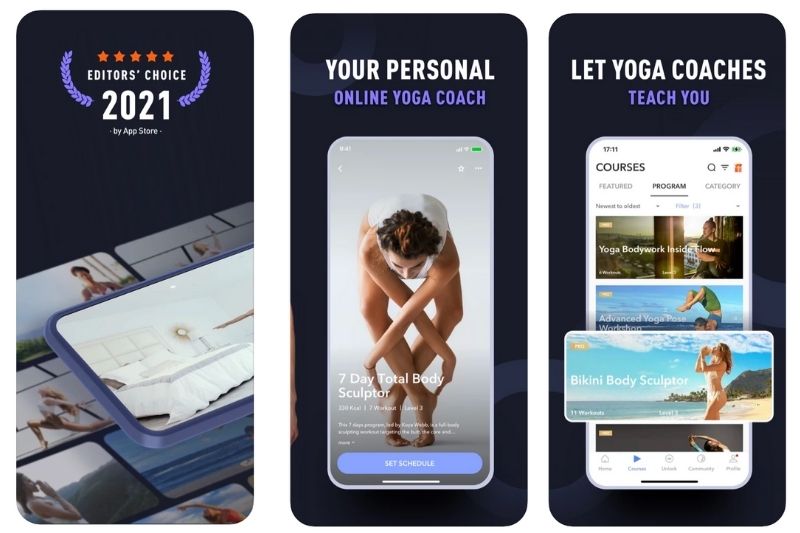
At Home Stretching Tools
It is important to invest in a proper stretching tool for stress relief and faster recovery time. Here are 4 tools to help relieve neck tension.
1. Foam Roller
Some benefits of using a foam roller is that it promotes relaxation from work stress, reduces inflammation which relieves pain, and it also can help with faster muscle rehabilitation. Foam rollers are often affordable and accessible, with many sizes available for different apartment sizes. There are many tutorial videos online to help you pinpoint trigger points and roll out any tight knots in your neck. However, it is important to seek out professional medical advice before purchasing and using a foam roller, as the wrong position may cause further damage to your spinal cords.
2. Acupressure Yoga Mat
There are many products similar to the Bed of Nails, which is a popular acupuncture tool to let your body heal tension and de-stress itself. The Korean pebble acupressure slippers can help decrease inflammation in your body by targeting specific areas on your foot that are believed to be connected to different parts of your body.
Similar to these tools, acupressure mats have sharp plastic points. The plastic spikes are able to target specific acupoints on your back and feet to reduce any pain or discomfort in your body. Simply lay on the mat for no more than 30 minutes, as your blood circulation level will increase, and once you get up, you will feel an instant relief on your body.
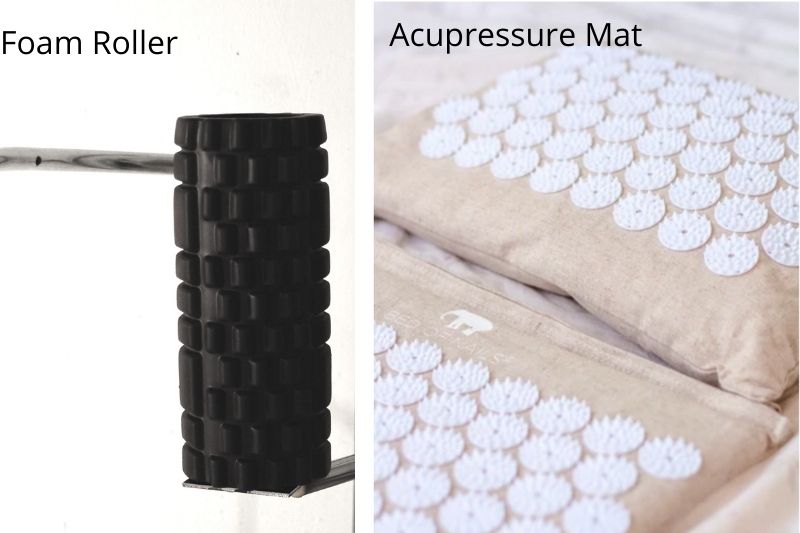
3. Portable Massage Device
For those looking for a lower impact tool than having sharp spikes poking your back, you can try investing in a massage device. A massager can help with self-massage, reaching areas that are hard to massage with just your hands. These devices can be used at home, and minimise the risk of leaving the house due to Covid. It is also important to be aware that these devices should only massage muscles and should never be used on bones or nerves as this could cause dislocation and bone fractures. Be sure to always contact a specialist before purchasing a massage device.
4. Lacrosse Ball
A lacrosse ball can help isolate specific areas of your neck- the small nooks and crooks that a foam roller or massage device cannot access. Although this alone won’t provide a long term fix, it can help provide fast relief during work breaks or evenings at home. Lacrosse balls are popular for neck pain relief because they are the perfect size, shape, and weight to better control movement when rolling on it.

Tech Neck Prevention Tips
Here are 4 preventative measures to reduce tech neck occurrence.
1. Take Regular Breaks
Having short breaks throughout your workday can improve productivity, eyesight, and attention level. It is recommended to take at least one 30 minute break every 2 – 4 hours. It’s hard to remember to take breaks when fully immersed in your work, so a good way to remember is to set alarms on your phone. Whether you are getting up to refill your mug or going to the bathroom, standing and walking will increase blood circulation, loosen neck muscles, and relieve spinal stress from sitting too long.
2. Raise Your Computer
In addition to taking breaks, your desk area should also accommodate your posture. Your computer should be at eye level as this will help straighten your back; a laptop stand is recommended to maintain proper posture. Your desk area should be wide enough where all your accessories like mouse, keyboard, and computer fit to prevent your shoulders from shrugging too much. To prevent eye strain and leaning forward, the distance between your eyes and the computer should be at least 50 cm (20 inches).
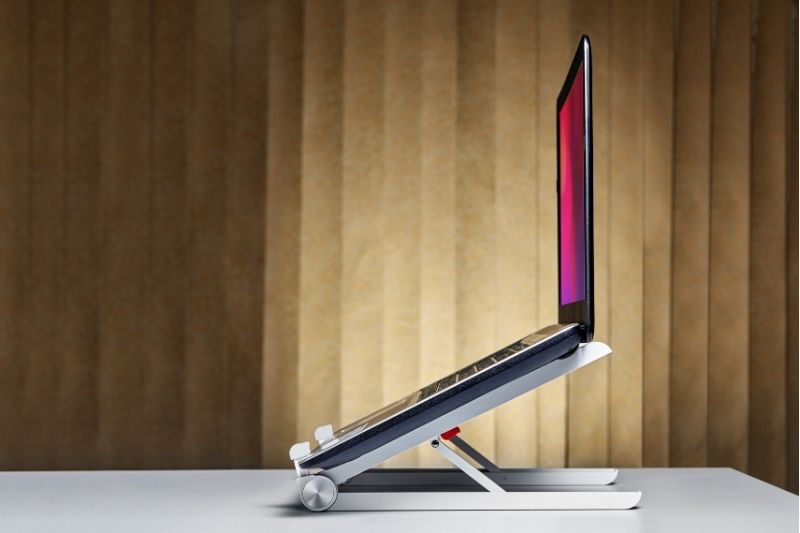
3. Stretch Daily
By making stretching a part of your daily routine, it will help loosen your muscles, increase flexibility, and decrease tension between the neck and shoulder muscles. There are wearable devices features and smartphone apps available to remind you to stretch as well, and it is best to take at least 20-30 minutes out of your day to stretch.
4. Maintain Good Posture
The biggest cause of neck pain is bad posture, whether it’s sitting or standing, it is always important to maintain a correct stance. When you are sitting, it is recommended to add a lower back cushion to reduce spinal compression and straighten your back. The worst place to work is on your bed, as the soft material cannot properly support your lower back- causing a heavy strain on your lower back and your neck to dip forward. To improve your posture, it is best to use a proper office chair to minimise neck pain occurrence. The best posture is to sit with your head back, ears directly above the shoulders, and your hands at 90 degrees from your head to the keyboard.
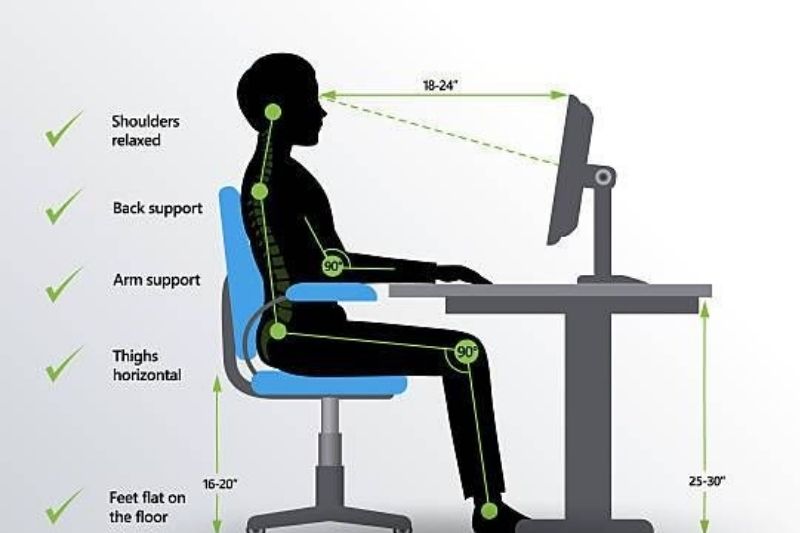
Related Articles
Home Workout Guide: 8 Absolute Best Ways to Stay Fit





